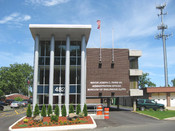As the first generation of Massachusetts Bay settlers began to die off by the middle of the 17th century, the Congregational churches faced a membership crisis. "Full participation had been limited to the 'Visible Saints' those who had made a public affirmation of their faith and had been accepted into membership by a vote of the congregation," (Mulder 134). The second and third generation of Puritans did not have the same religious ambition their fathers had before them. Economic conditions had greatly improved, and individuals were paying increasingly less attention to the congregation. Ministers soon found them selves preaching to empty pews, as fewer became full members of the church. Limited individuals felt confident enough to make the necessary public declarations to become a full member. "Shockingly, more women than men did so, which led to an increasing feminization of church membership, also a matter of deep concern in a male-dominated society,"( Mulder 149).
In 1662, several congregations met and approved the "Half-Way Covenant."
The churches devised this covenant to provide a limited form of membership. This partial membership allowed people that were baptized into the church, not yet full members, to baptize their children into the church as well. Even with this membership, one would have to become a full member to partake in Communion or voting on church matters. Only a few New England congregations accepted this compromise. "Political forces within the colonies tended to support the relaxation of church membership rules since the right to vote on civil matters was reserved for the 'Visible Saints'," (Olmstead 224). The essential cohesion of the early Puritan communities was forgone. A split had developed between the fundamentalists, who wanted to maintain religious purity at any cost, and the more liberal thinkers, who believed that a stronger society could...


